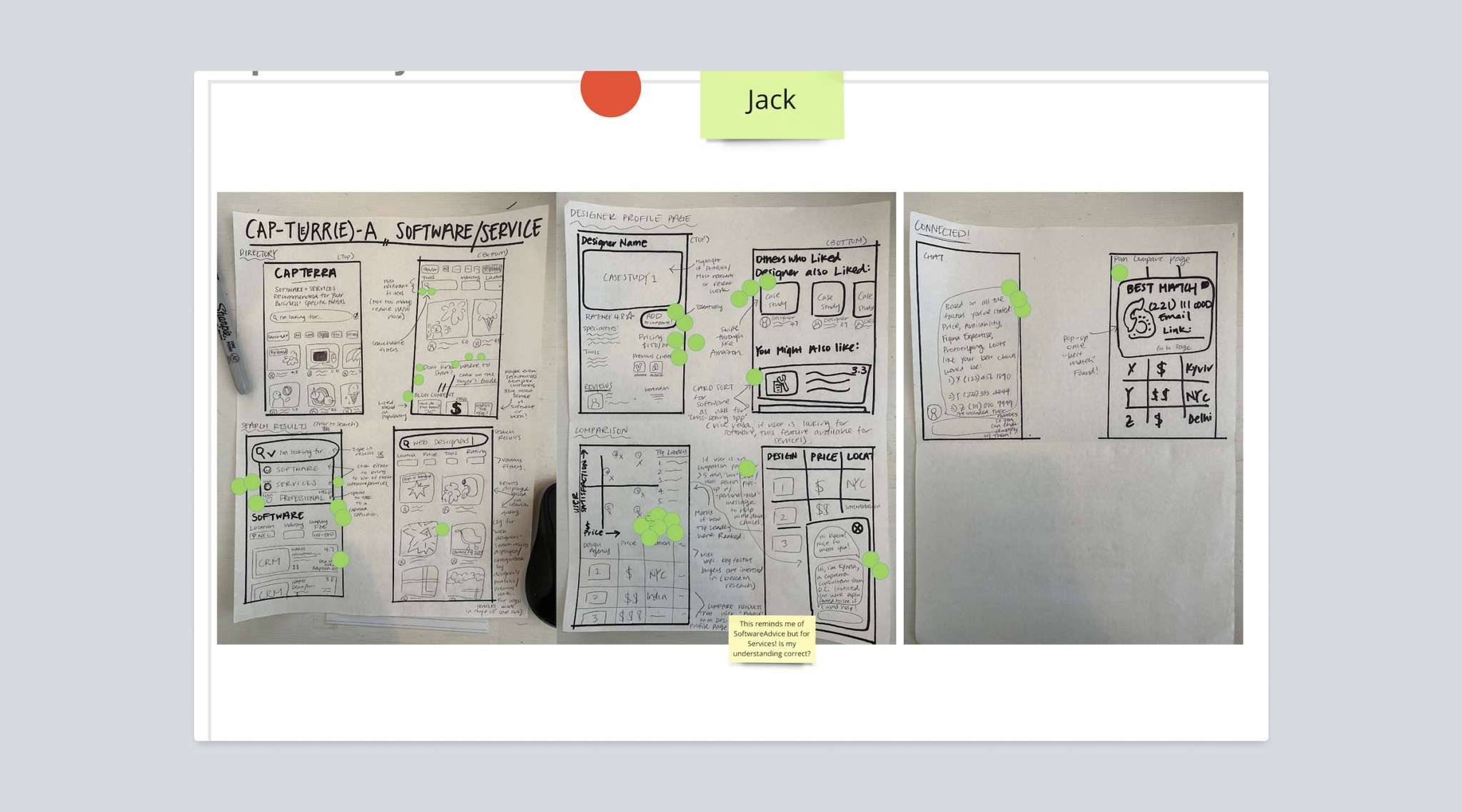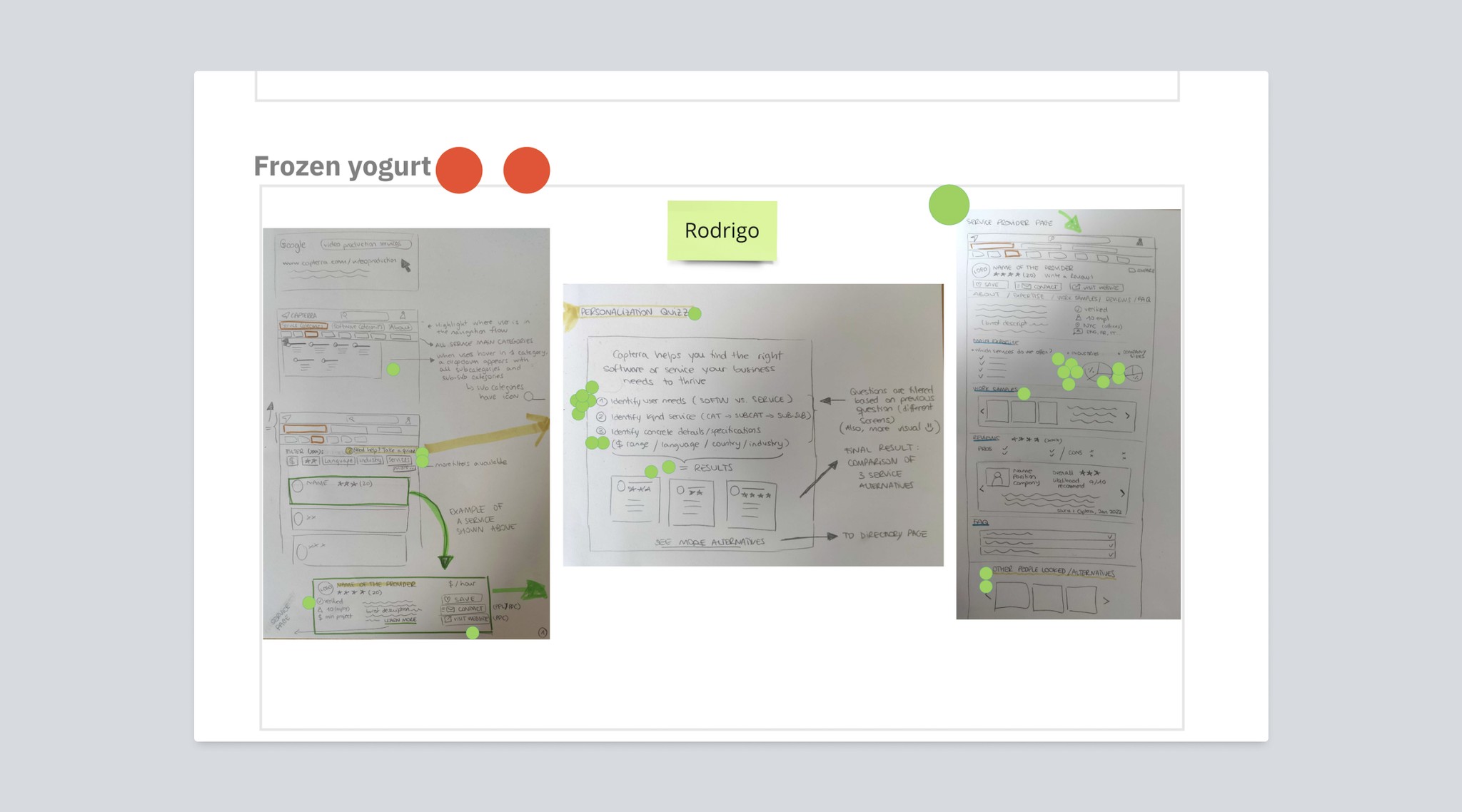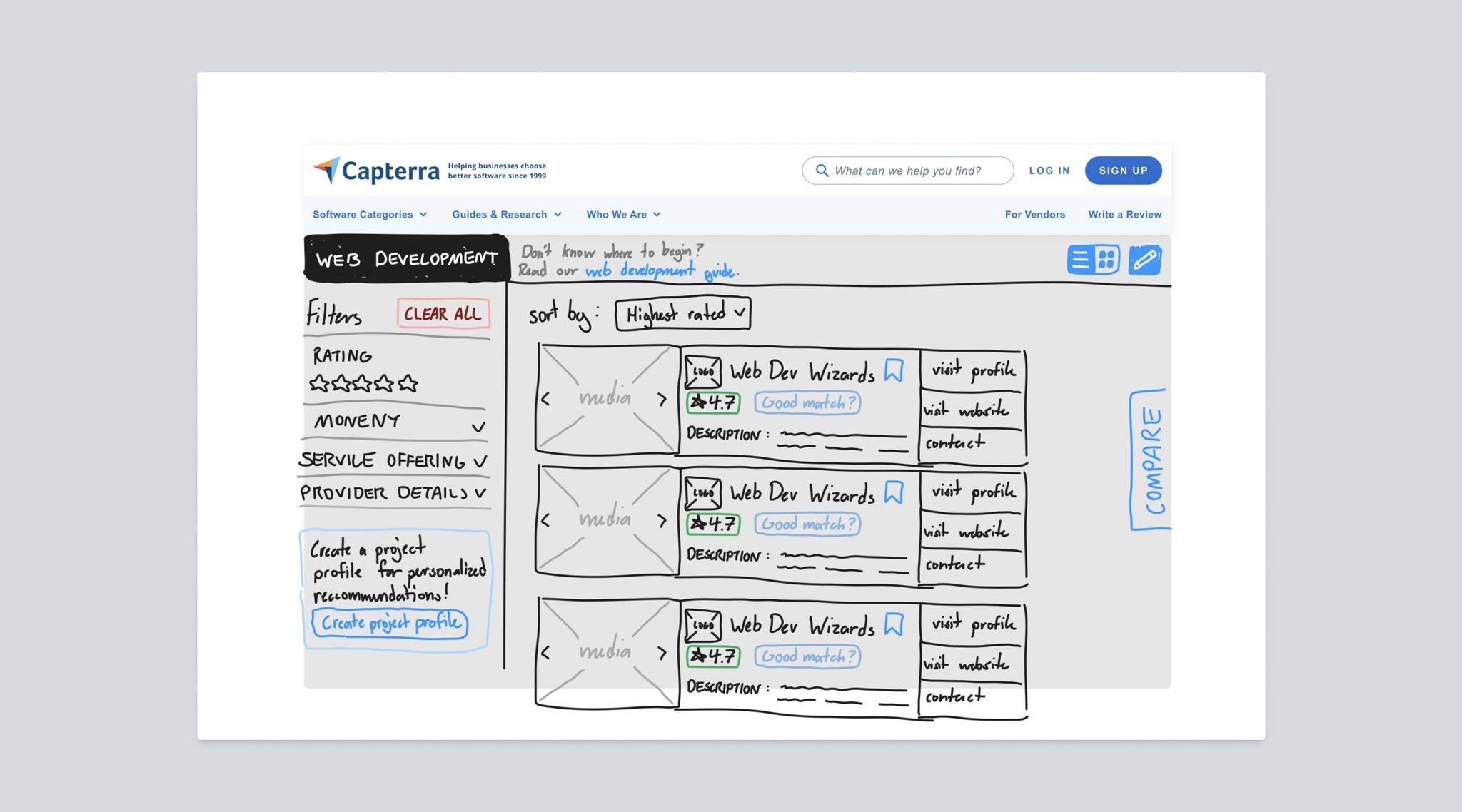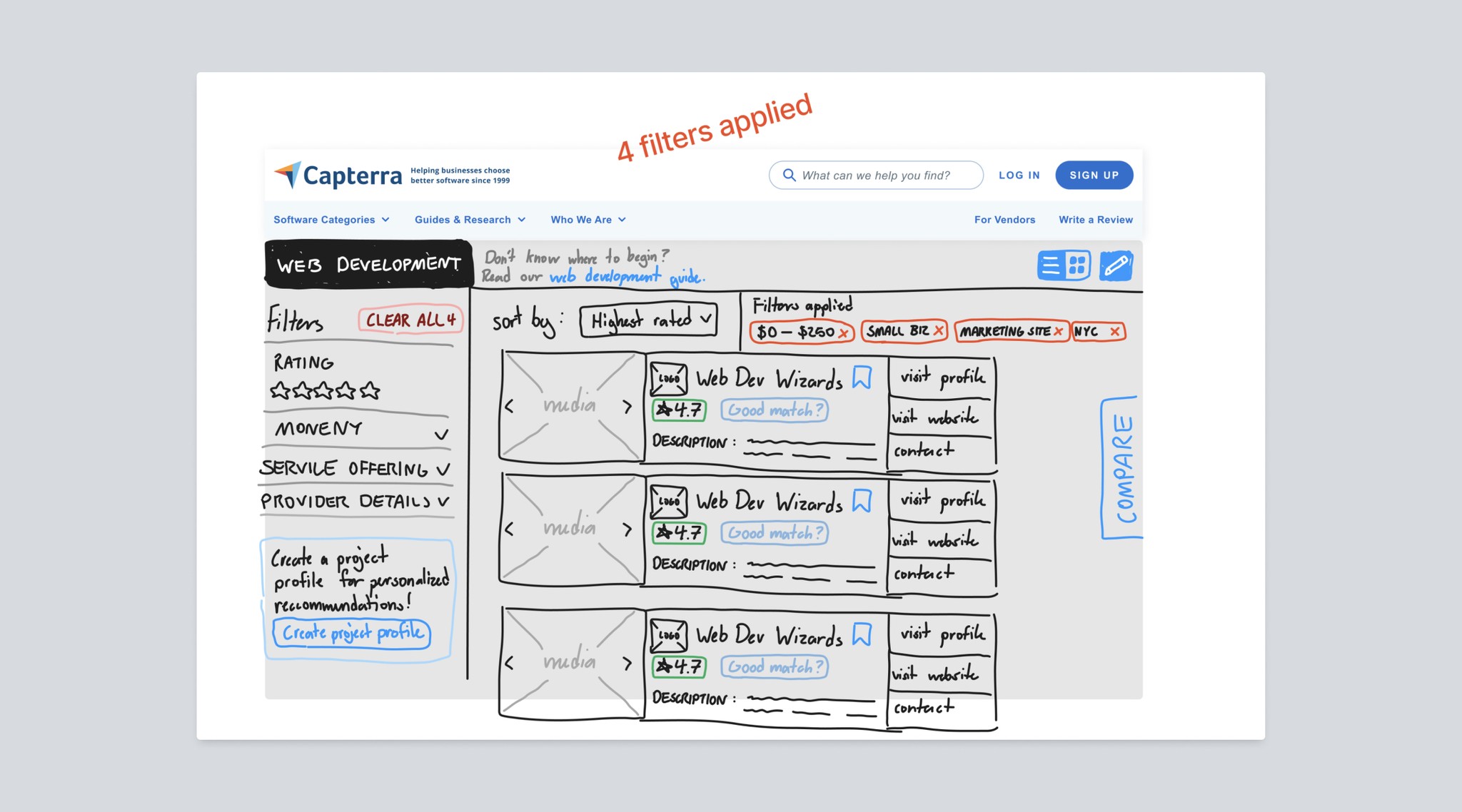
Services Marketplace
Product Designer | Q2 - Q4 2022 | Gartner Digital Markets
Services Marketplace
Product Designer | Q2 - Q4 2022 | Gartner Digital Markets
Project Overview
Capterra is a leading marketplace for finding and comparing software. Our mission is to help organizations save time, increase productivity, and accelerate growth by finding the right resources. Our team recognized a huge opportunity to expand into the services market, which would further support our organization's mission critical priorities while opening up multiple new streams of potential revenue and increased traffic.
Project Overview
Capterra is a leading marketplace for finding and comparing software. Our mission is to help organizations save time, increase productivity, and accelerate growth by finding the right resources. Our team recognized a huge opportunity to expand into the services market, which would further support our organization's mission critical priorities while opening up multiple new streams of potential revenue and increased traffic.
The Goal
Our primary objective was to successfully launch a minimum viable product (MVP) of index pages and vendor profile pages across 12 distinct categories that would allow us to drive traffic to our site, collect valuable data, and iterate rapidly. The ultimate purpose of these efforts was to pave the way for achieving our monetization milestone.
The Goal
Our primary objective was to successfully launch a minimum viable product (MVP) of index pages and vendor profile pages across 12 distinct categories that would allow us to drive traffic to our site, collect valuable data, and iterate rapidly. The ultimate purpose of these efforts was to pave the way for achieving our monetization milestone.
Opportunities
Services provide an opportunity for increased engagement with end-users who we otherwise intercept only when they need to make software purchasing decisions.
Small and medium-sized business (SMB) buyers seeking to purchase software often search for assistance in finding related services, either for implementation purposes or as a potential substitution for the product they are currently considering.
Launching new software categories was starting to yield diminishing returns, limiting the scalability of our software offerings.
Increase the number of potential vendors/providers that we can target for ad revenue.
Long-term total global revenue opportunity for Gartner
Opportunities
Services provide an opportunity for increased engagement with end-users who we otherwise intercept only when they need to make software purchasing decisions.
Small and medium-sized business (SMB) buyers seeking to purchase software often search for assistance in finding related services, either for implementation purposes or as a potential substitution for the product they are currently considering.
Launching new software categories was starting to yield diminishing returns, limiting the scalability of our software offerings.
Increase the number of potential vendors/providers that we can target for ad revenue.
Long-term total global revenue opportunity for Gartner
Outcomes
17% quarter-over-quarter increase in site traffic overall from date of launch
Substantial revenue growth for our Services business unit
Successfully conducted four rapid prototype tests, significantly improving trust and utility scores.
Outcomes
17% quarter-over-quarter increase in site traffic overall from date of launch
Substantial revenue growth for our Services business unit
Successfully conducted four rapid prototype tests, significantly improving trust and utility scores.

Competitive Analysis
Understanding the competitive environment was crucial if we aimed to create an experience that stood out in the market. Our competitive analysis allowed us to dive deep into the strategies, strengths, and weaknesses of key market players, providing a comprehensive overview of the current trends and user expectations.
The following points provide a brief overview of our analysis and highlight the most significant elements that stood out in our analysis of Clutch, our biggest competitor in the space.
Utilize both Pay per Click and Pay per Lead monetization models
93 active service categories
Minimum $500 monthly budget for vendors to participate
Several sorting options on directory pages, though some are confusing and not explained well.
Sponsor sort by default prioritizes monetized vendors.
High degree of filtering granularity.
Interesting use of data visualizations that sometimes miss the mark, or are entirely unusable.
Competitive Analysis
Understanding the competitive environment was crucial if we aimed to create an experience that stood out in the market. Our competitive analysis allowed us to dive deep into the strategies, strengths, and weaknesses of key market players, providing a comprehensive overview of the current trends and user expectations.
The following points provide a brief overview of our analysis and highlight the most significant elements that stood out in our analysis of Clutch, our biggest competitor in the space.
Utilize both Pay per Click and Pay per Lead monetization models
93 active service categories
Minimum $500 monthly budget for vendors to participate
Several sorting options on directory pages, though some are confusing and not explained well.
Sponsor sort by default prioritizes monetized vendors.
High degree of filtering granularity.
Interesting use of data visualizations that sometimes miss the mark, or are entirely unusable.

Discovery Process & Defining the Scope
Before diving into ideation, we needed a better understanding of our technical constraints and the data available to us.
This phase involved significant collaboration, bringing together our Data Engineers and the Catalog and Reviews Product teams. This collaboration was important in ensuring that our MVP was both feasible and informed by the data and technical resources available to us. Below is the data model used to inform the MVP design.
Discovery Process & Defining the Scope
Before diving into ideation, we needed a better understanding of our technical constraints and the data available to us.
This phase involved significant collaboration, bringing together our Data Engineers and the Catalog and Reviews Product teams. This collaboration was important in ensuring that our MVP was both feasible and informed by the data and technical resources available to us. Below is the data model used to inform the MVP design.
Discovery Process & Defining the Scope
Before diving into ideation, we needed a better understanding of our technical constraints and the data available to us.
This phase involved significant collaboration, bringing together our Data Engineers and the Catalog and Reviews Product teams. This collaboration was important in ensuring that our MVP was both feasible and informed by the data and technical resources available to us. Below is the data model used to inform the MVP design.

Design Sprint
At Gartner, each project begins with a comprehensive ideation session. Given the novelty of this product offering, we dedicated five full days to a Design Sprint. In this process, I played a dual role, both facilitating and actively engaging in the sketching exercises.
Over five days we:
Mapped: We interviewed experts across GDM to identify and prioritize problems to solve
Sketched: We found inspiration and sketched examples of potential solutions
Decided: We created ideal user flows and storyboarded our prototype
Prototyped: We created a functional prototype for testing
Tested: We had several external (and one internal) user test and provide feedback
Design Sprint
At Gartner, each project begins with a comprehensive ideation session. Given the novelty of this product offering, we dedicated five full days to a Design Sprint. In this process, I played a dual role, both facilitating and actively engaging in the sketching exercises.
Over five days we:
Mapped: We interviewed experts across GDM to identify and prioritize problems to solve
Sketched: We found inspiration and sketched examples of potential solutions
Decided: We created ideal user flows and storyboarded our prototype
Prototyped: We created a functional prototype for testing
Tested: We had several external (and one internal) user test and provide feedback
Design Sprint
At Gartner, each project begins with a comprehensive ideation session. Given the novelty of this product offering, we dedicated five full days to a Design Sprint. In this process, I played a dual role, both facilitating and actively engaging in the sketching exercises.
Over five days we:
Mapped: We interviewed experts across GDM to identify and prioritize problems to solve
Sketched: We found inspiration and sketched examples of potential solutions
Decided: We created ideal user flows and storyboarded our prototype
Prototyped: We created a functional prototype for testing
Tested: We had several external (and one internal) user test and provide feedback

After some initial ideation and voting by everyone from the team, we crafted a long-term user goal that we would use as a north star for the rest of our week.
Our Sprint Goal: Users are able to easily identify what they are looking for and understand the difference between software and services with high confidence. Capterra organically becomes the "Google" for users searching for software/services.
After some initial ideation and voting by everyone from the team, we crafted a long-term user goal that we would use as a north star for the rest of our week.
Our Sprint Goal: Users are able to easily identify what they are looking for and understand the difference between software and services with high confidence. Capterra organically becomes the "Google" for users searching for software/services.
After some initial ideation and voting by everyone from the team, we crafted a long-term user goal that we would use as a north star for the rest of our week.
Our Sprint Goal: Users are able to easily identify what they are looking for and understand the difference between software and services with high confidence. Capterra organically becomes the "Google" for users searching for software/services.

After developing our map, we initiated a series of interviews with experts and stakeholders throughout the organization. This step was crucial for deepening our understanding of the core issues at hand.
During these discussions, participants were encouraged to jot down 'How Might We' (HMW) notes. These notes were pivotal in capturing immediate thoughts and insights. Following the interviews, our team gathered to organize these HMW notes into meaningful clusters, a process known as affinitization. This exercise culminated in a voting process, where we collectively identified and prioritized the most compelling and actionable insights.
After developing our map, we initiated a series of interviews with experts and stakeholders throughout the organization. This step was crucial for deepening our understanding of the core issues at hand.
During these discussions, participants were encouraged to jot down 'How Might We' (HMW) notes. These notes were pivotal in capturing immediate thoughts and insights. Following the interviews, our team gathered to organize these HMW notes into meaningful clusters, a process known as affinitization. This exercise culminated in a voting process, where we collectively identified and prioritized the most compelling and actionable insights.
After developing our map, we initiated a series of interviews with experts and stakeholders throughout the organization. This step was crucial for deepening our understanding of the core issues at hand.
During these discussions, participants were encouraged to jot down 'How Might We' (HMW) notes. These notes were pivotal in capturing immediate thoughts and insights. Following the interviews, our team gathered to organize these HMW notes into meaningful clusters, a process known as affinitization. This exercise culminated in a voting process, where we collectively identified and prioritized the most compelling and actionable insights.

We then developed a comprehensive map to visualize how we anticipate our customers interacting with our future-state directory pages. This visualization was key in enabling us to hyper-focus our efforts. By doing so, we aimed to align our immediate tasks with our long-term sprint goal, ensuring that every step we took was directed towards enhancing user experience and meeting our projected targets.
We then developed a comprehensive map to visualize how we anticipate our customers interacting with our future-state directory pages. This visualization was key in enabling us to hyper-focus our efforts. By doing so, we aimed to align our immediate tasks with our long-term sprint goal, ensuring that every step we took was directed towards enhancing user experience and meeting our projected targets.
We then developed a comprehensive map to visualize how we anticipate our customers interacting with our future-state directory pages. This visualization was key in enabling us to hyper-focus our efforts. By doing so, we aimed to align our immediate tasks with our long-term sprint goal, ensuring that every step we took was directed towards enhancing user experience and meeting our projected targets.

After identifying our focus areas, the next step was to start ideating. Every team member took some time to individually brainstorm and sketch out potential solutions aligned with our sprint goal. The images below represent a selection of these solution sketches, showcasing a range of creative solutions taken by our team.
After identifying our focus areas, the next step was to start ideating. Every team member took some time to individually brainstorm and sketch out potential solutions aligned with our sprint goal. The images below represent a selection of these solution sketches, showcasing a range of creative solutions taken by our team.
After identifying our focus areas, the next step was to start ideating. Every team member took some time to individually brainstorm and sketch out potential solutions aligned with our sprint goal. The images below represent a selection of these solution sketches, showcasing a range of creative solutions taken by our team.
Storyboarding
At the conclusion of our ideation session, the team discussed and voted on our favorite concepts. This collaborative selection process was pivotal in determining which ideas would advance to our storyboarding phase. During storyboarding, we shifted our focus to envisioning the user scenarios. We started to concretely define what we would present to our users for testing, ensuring that our concepts were not only meeting our sprint goal but also practical and user-centric.
Storyboarding
At the conclusion of our ideation session, the team discussed and voted on our favorite concepts. This collaborative selection process was pivotal in determining which ideas would advance to our storyboarding phase. During storyboarding, we shifted our focus to envisioning the user scenarios. We started to concretely define what we would present to our users for testing, ensuring that our concepts were not only meeting our sprint goal but also practical and user-centric.
Storyboarding
At the conclusion of our ideation session, the team discussed and voted on our favorite concepts. This collaborative selection process was pivotal in determining which ideas would advance to our storyboarding phase. During storyboarding, we shifted our focus to envisioning the user scenarios. We started to concretely define what we would present to our users for testing, ensuring that our concepts were not only meeting our sprint goal but also practical and user-centric.
The Prototype
With our storyboard complete, the next step was to progress to creating high-definition designs. This phase was especially challenging due to our tight schedule — we had just one day to develop our prototype. This time constraint necessitated a swift yet meticulous approach, as we aimed to craft a prototype that was both polished and user-friendly, ready to be presented to our users for valuable feedback.
The Prototype
With our storyboard complete, the next step was to progress to creating high-definition designs. This phase was especially challenging due to our tight schedule — we had just one day to develop our prototype. This time constraint necessitated a swift yet meticulous approach, as we aimed to craft a prototype that was both polished and user-friendly, ready to be presented to our users for valuable feedback.
The Prototype
With our storyboard complete, the next step was to progress to creating high-definition designs. This phase was especially challenging due to our tight schedule — we had just one day to develop our prototype. This time constraint necessitated a swift yet meticulous approach, as we aimed to craft a prototype that was both polished and user-friendly, ready to be presented to our users for valuable feedback.



Assumptions & Hypothesis to Test
Users would find information on cards such as industry focus and metadata insightful and useful for making hiring decisions
Filters provide a helpful way to personalize the service hiring experience.
By creating a project profile, users can further customize their experience. This functionality addresses the common pain point of uncertainty in choosing the right provider, ensuring a more confident and satisfactory decision-making process.
Capterra verified badges add an addtional layer of trust, and serve as a seal of credibility, assisting users in navigating their choices with greater confidence and assurance.
For users uncertain about their exact needs, providing alternative choices like DIY software solutions could significantly enhance the utility of our platform.
Assumptions & Hypothesis to Test
Assumptions & Hypothesis to Test
Users would find information on cards such as industry focus and metadata insightful and useful for making hiring decisions
Filters provide a helpful way to personalize the service hiring experience.
By creating a project profile, users can further customize their experience. This functionality addresses the common pain point of uncertainty in choosing the right provider, ensuring a more confident and satisfactory decision-making process.
Capterra verified badges add an addtional layer of trust, and serve as a seal of credibility, assisting users in navigating their choices with greater confidence and assurance.
For users uncertain about their exact needs, providing alternative choices like DIY software solutions could significantly enhance the utility of our platform.
We need a methodology and plan to scale service provider verification to build trust in our offering.
Verification by Capterra gave users confidence in our brand and the vendors on our site.
Several users called out how verification signals included in the prototype were very important for trust
Users expected to be able to drill into what we meant when a vendor was “verified”
We need a methodology and plan to scale service provider verification to build trust in our offering.
Verification by Capterra gave users confidence in our brand and the vendors on our site.
Several users called out how verification signals included in the prototype were very important for trust
Users expected to be able to drill into what we meant when a vendor was “verified”
We need a methodology and plan to scale service provider verification to build trust in our offering.
Verification by Capterra gave users confidence in our brand and the vendors on our site.
Several users called out how verification signals included in the prototype were very important for trust
Users expected to be able to drill into what we meant when a vendor was “verified”

Service focus is helpful for users to determine which providers are a good fit.
We should strongly consider implementing provider focus as a filter for our MVP
We should explore in further iterations if having this visualization is necessary to display in cards
We need to further explore how industry fits into hiring decision making.
When prompted, some users indicated they thought it could be helpful, but we need to continue to explore.
Service focus is helpful for users to determine which providers are a good fit.
We should strongly consider implementing provider focus as a filter for our MVP
We should explore in further iterations if having this visualization is necessary to display in cards
We need to further explore how industry fits into hiring decision making.
When prompted, some users indicated they thought it could be helpful, but we need to continue to explore.
Service focus is helpful for users to determine which providers are a good fit.
We should strongly consider implementing provider focus as a filter for our MVP
We should explore in further iterations if having this visualization is necessary to display in cards
We need to further explore how industry fits into hiring decision making.
When prompted, some users indicated they thought it could be helpful, but we need to continue to explore.

Direct communication with vendors creates challenges for users and potential opportunities for our product.
Users liked our communication options, but relayed multiple pain points related to communication with vendors.
More experienced users had apprehension about filling out a vendor form because previous form fills were ignored by vendors.
Users specifically called out wanting to be able to chat or call vendors directly. Projects are time sensitive and they don’t have time to wait.
Direct communication with vendors creates challenges for users and potential opportunities for our product.
Users liked our communication options, but relayed multiple pain points related to communication with vendors.
More experienced users had apprehension about filling out a vendor form because previous form fills were ignored by vendors.
Users specifically called out wanting to be able to chat or call vendors directly. Projects are time sensitive and they don’t have time to wait.
Direct communication with vendors creates challenges for users and potential opportunities for our product.
Users liked our communication options, but relayed multiple pain points related to communication with vendors.
More experienced users had apprehension about filling out a vendor form because previous form fills were ignored by vendors.
Users specifically called out wanting to be able to chat or call vendors directly. Projects are time sensitive and they don’t have time to wait.

Users liked the project profile, but wanted to know why and how we were recommending service providers to them.
The idea of getting a “Best Fit” Provider was more delightful than receiving a list of “Top” providers.
Users liked us recommending service providers and DIY tools, but wanted to know more about why these were a good fit for them.
Another participant liked the offering reviews of the third option, but wanted to be able to compare those against the other recommended providers.
Users liked the project profile, but wanted to know why and how we were recommending service providers to them.
The idea of getting a “Best Fit” Provider was more delightful than receiving a list of “Top” providers.
Users liked us recommending service providers and DIY tools, but wanted to know more about why these were a good fit for them.
Another participant liked the offering reviews of the third option, but wanted to be able to compare those against the other recommended providers.
Users liked the project profile, but wanted to know why and how we were recommending service providers to them.
The idea of getting a “Best Fit” Provider was more delightful than receiving a list of “Top” providers.
Users liked us recommending service providers and DIY tools, but wanted to know more about why these were a good fit for them.
Another participant liked the offering reviews of the third option, but wanted to be able to compare those against the other recommended providers.

Users wanted info like company size and links to completed projects to determine quality and fit.
In addition to portfolio visuals, being able to visit actual websites that vendors built is helpful in determining quality.
Some users felt more confidence in a vendor if they perceived staff size to be robust.
Users wanted info like company size and links to completed projects to determine quality and fit.
In addition to portfolio visuals, being able to visit actual websites that vendors built is helpful in determining quality.
Some users felt more confidence in a vendor if they perceived staff size to be robust.
Users wanted info like company size and links to completed projects to determine quality and fit.
In addition to portfolio visuals, being able to visit actual websites that vendors built is helpful in determining quality.
Some users felt more confidence in a vendor if they perceived staff size to be robust.

Building the Product
With the completion of our Design Sprint, we transitioned into the product development phase. The first step involved collaboration with various teams and stakeholders to share our process and findings. This collaborative approach was instrumental in evaluating the feasibility of our ideas and refining them for our MVP launch.
Given our tight timeline, we prioritized speed without compromising on quality. Our time constraints led us to develop a basic, yet functional wireframe, which we swiftly handed over to our engineering team. These preliminary wireframes served as the foundation for establishing our data model in a staging environment. This setup allowed us to iteratively refine our product, ultimately guiding us towards a robust, production-ready MVP.
Building the Product
With the completion of our Design Sprint, we transitioned into the product development phase. The first step involved collaboration with various teams and stakeholders to share our process and findings. This collaborative approach was instrumental in evaluating the feasibility of our ideas and refining them for our MVP launch.
Given our tight timeline, we prioritized speed without compromising on quality. Our time constraints led us to develop a basic, yet functional wireframe, which we swiftly handed over to our engineering team. These preliminary wireframes served as the foundation for establishing our data model in a staging environment. This setup allowed us to iteratively refine our product, ultimately guiding us towards a robust, production-ready MVP.
Building the Product
With the completion of our Design Sprint, we transitioned into the product development phase. The first step involved collaboration with various teams and stakeholders to share our process and findings. This collaborative approach was instrumental in evaluating the feasibility of our ideas and refining them for our MVP launch.
Given our tight timeline, we prioritized speed without compromising on quality. Our time constraints led us to develop a basic, yet functional wireframe, which we swiftly handed over to our engineering team. These preliminary wireframes served as the foundation for establishing our data model in a staging environment. This setup allowed us to iteratively refine our product, ultimately guiding us towards a robust, production-ready MVP.
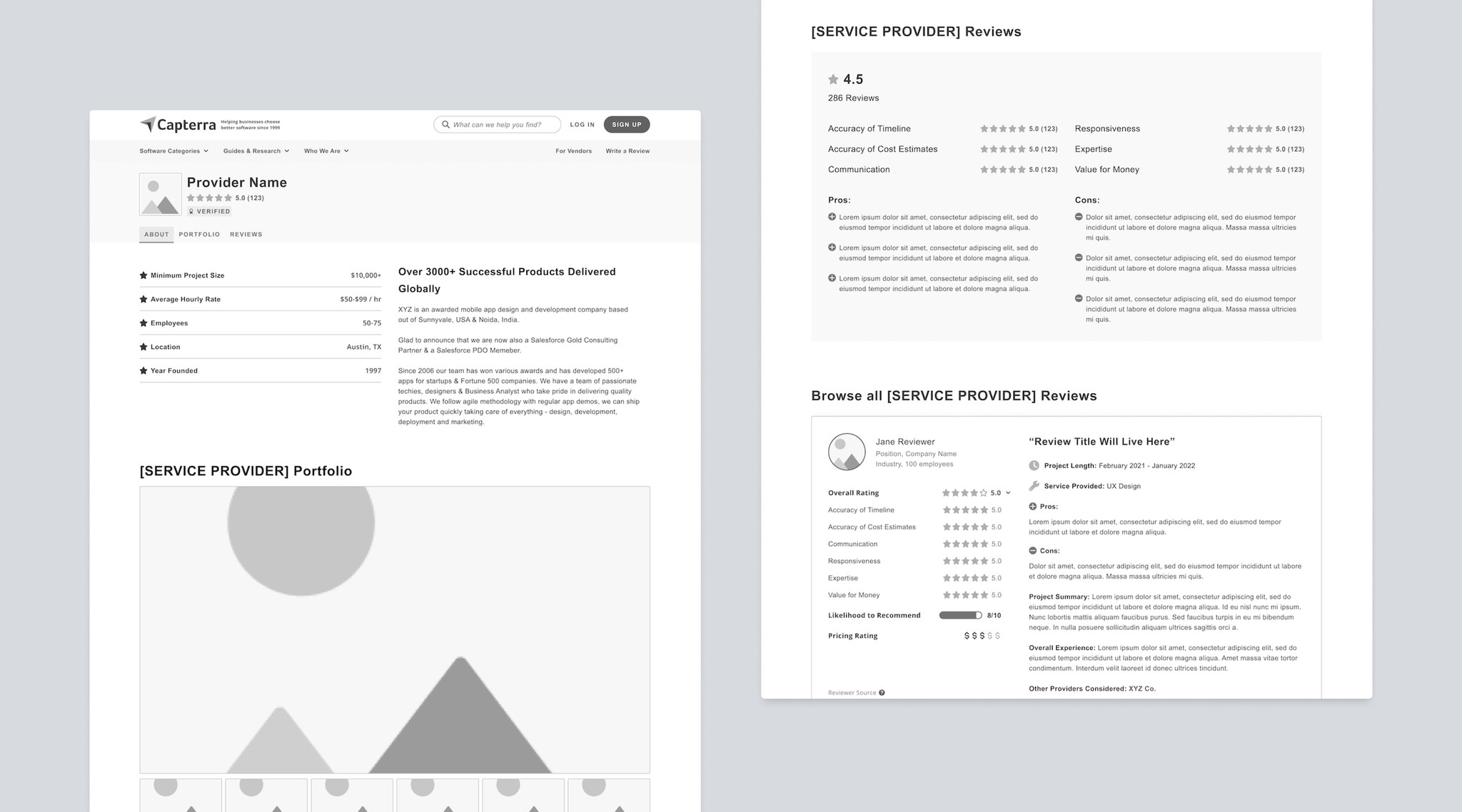
Our Final MVP
After taking into account user feedback, technology constraints and input from various stakeholders we were finally ready to launch our MVP.
Highlighting Key Features:
Provider data that relies on our trusted user reviews increases trust.
Robust location data for providers.
Robust reviews insights on provider profile pages.
Prioritization of cost and industry data based on feedback of importance from our users.
Filtering logic based on data that our users found most important when comparing service providers.
Our Final MVP
After taking into account user feedback, technology constraints and input from various stakeholders we were finally ready to launch our MVP.
Highlighting Key Features:
Provider data that relies on our trusted user reviews increases trust.
Robust location data for providers.
Robust reviews insights on provider profile pages.
Prioritization of cost and industry data based on feedback of importance from our users.
Filtering logic based on data that our users found most important when comparing service providers.
Our Final MVP
After taking into account user feedback, technology constraints and input from various stakeholders we were finally ready to launch our MVP.
Highlighting Key Features:
Provider data that relies on our trusted user reviews increases trust.
Robust location data for providers.
Robust reviews insights on provider profile pages.
Prioritization of cost and industry data based on feedback of importance from our users.
Filtering logic based on data that our users found most important when comparing service providers.






